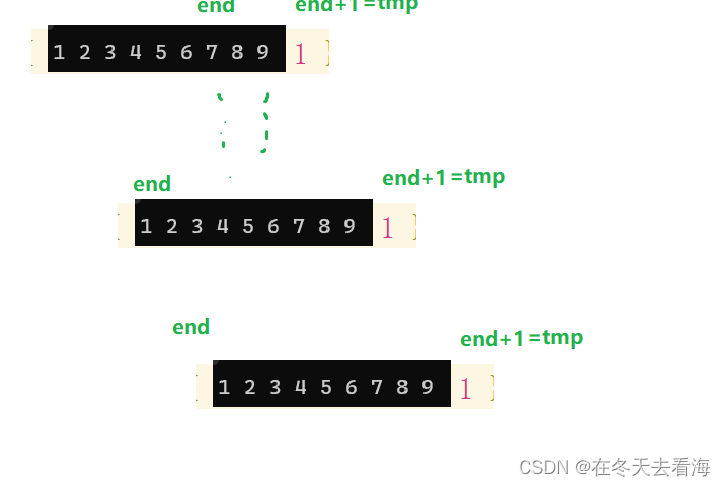-
数据结构插入排序

好久不见,这几天有点事情,都快一个礼拜没有学习,对键盘都要陌生起来了,今天也是刚刚学了一点排序,在这里也给大家更新一个插入排序,后面也会渐渐的把八大排序更新完的,还有就是二叉树,二叉树小编能力有限,可能也是学了一点点,废话不多说,我们进入今天的学习吧。插入排序和我们之前学过的冒泡排序有一点相似之处,首先他们的空间复杂度都是O(N*N),插入排序的整个过程是怎么样的呢,首先我们先引入一个小问题,那就是我们将一个数插入到一个升序的有序列数组当中,我们是怎样插入的,首先我们应该拿这个数去进行比较,从末尾开始比,如果比这个数大我们就要继续往前找,一直到找到大于或者等于这个数的时候,我们在这个数的末尾进行插入,在插入过程中,如果这个数比其他数要小的时候,其他数应该要往后移动,相当于是一个覆盖的思路,我们这里给一个图,让大家比较好理解。


我们end一直往前面走,一直到找到合适的位置才停止,中间还有一个过程是覆盖,画图里没有体现出来,就是不满足条件就往后移动覆盖,我们用代码看看可能更好来理解。int end = 9; int tmp = a[end + 1]; while (end >= 0) { if (tmp < a[end]) { a[end + 1] = a[end]; end--; } else { break; } } a[end+1] = tmp; }- 1
- 2
- 3
- 4
- 5
- 6
- 7
- 8
- 9
- 10
- 11
- 12
- 13
- 14
- 15
- 16
假设我们有九个数,现在就是要把1放入这个数组当中我们改怎么做呢,上面的代码就可以体现出来,那么我们有这个思路之后,我们是不是可以模拟到插入排序当中,其实很简单只要在我外面套一个循环就能实现了,那我们来试一试吧
void InsertSort(int* a, int n) { int i = 0; for (i = 0; i < n - 1; i++) { int end = i; int tmp = a[end + 1]; while (end >= 0) { if (tmp < a[end]) { a[end + 1] = a[end]; end--; } else { break; } } a[end+1] = tmp; } }- 1
- 2
- 3
- 4
- 5
- 6
- 7
- 8
- 9
- 10
- 11
- 12
- 13
- 14
- 15
- 16
- 17
- 18
- 19
- 20
- 21
- 22
- 23
这个样子就能把我们的插入排序实现了,我们也可以测试一下
头文件
InsertSort.h#includevoid InsertSort(int* a, int n); void PrintInsert(int* a, int n); - 1
- 2
- 3
- 4
- 5
- 6
InsertSort.c
#include"Insert.h" void InsertSort(int* a, int n) { int i = 0; for (i = 0; i < n - 1; i++) { int end = i; int tmp = a[end + 1]; while (end >= 0) { if (tmp < a[end]) { a[end + 1] = a[end]; end--; } else { break; } } a[end+1] = tmp; } } void PrintInsert(int* a, int n) { int i = 0; for (i = 0; i < n; i++) { printf("%d ", a[i]); } printf("\n"); }- 1
- 2
- 3
- 4
- 5
- 6
- 7
- 8
- 9
- 10
- 11
- 12
- 13
- 14
- 15
- 16
- 17
- 18
- 19
- 20
- 21
- 22
- 23
- 24
- 25
- 26
- 27
- 28
- 29
- 30
- 31
- 32
- 33
- 34
Test.c
int main() { int arr[] = { 9,8,7,6,5,4,3,2,1 }; InsertSort(arr, sizeof(arr) / sizeof(int)); PrintInsert(arr, sizeof(arr) / sizeof(int)); return 0; }- 1
- 2
- 3
- 4
- 5
- 6
- 7
调试之后就能把它变成有序的了,今天我们就讲一个排序,因为小编偷懒,今天只学了一个排序哈哈哈哈
我们下次再见
-
相关阅读:
LDO的原理及测试方法
leetcode 460. LFU 缓存
xss跨站脚本攻击姿势大全
计算机毕业设计Java学科竞赛管理系统(源码+系统+mysql数据库+Lw文档)
如何看待人工智能行业发展
医疗大数据系统
iceberg合并小文件冲突测试
基于目录的ant任务
教育ADOBE账号登录一直失败解决办法
Linux--vim
- 原文地址:https://blog.csdn.net/2301_76895050/article/details/132698989
